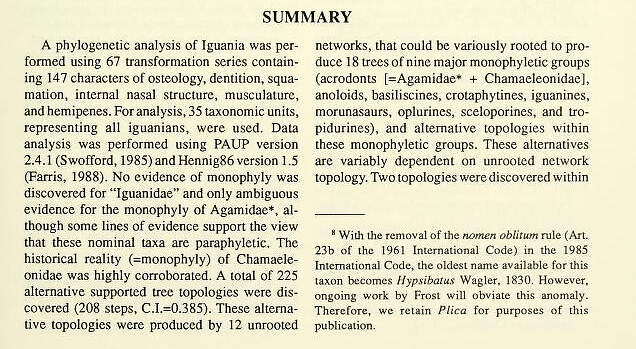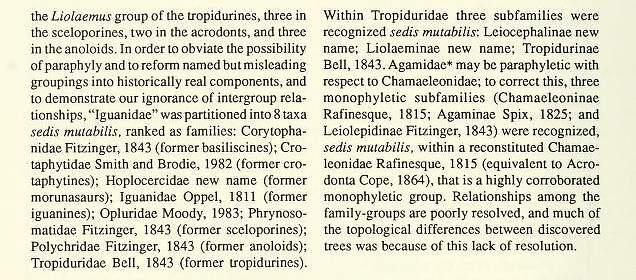KOCH, C., VENEGAS, P., GARCÍA-BRAVO, A., BÖHME, W. (2011)
A new bush anole (Iguanidae, Polychrotinae, Polychrus) from the upper Marañon basin, Peru, with a redescription of Polychrus peruvianus (Noble, 1924) and additional information on Polychrus gutturosus Berthold, 1845.
ZooKeys 141 : 79–107, doi: 10.3897/zookeys.141.1678.
Abstract:
We herein describe a new colorful species of Polychrus with a conspicuous sexual dimorphism from the dry forest of the northern portion of Región de La Libertad, Peru. The new species differs from all other Polychrus species, in that this species has very small dorsal scales and thus a higher number of scales around midbody and in the middorsal line from behind the occipital scales to the level of the posterior edge of the thigh. Furthermore, we redescribe Polychrus peruvianus whose original description is short and lacks information on intraspecific variation and sexual dimorphism. Also, we add some information on intraspecific variation and ecology of Polychrus gutturosus. Finally, we synonymize Polychrus spurrelli Boulenger with Polychrus gutturosus.
KÖHLER, G. (2002)
Schwarzleguane: Lebensweise - Pflege - Zucht
2. stark erweiterte Auflage. 142 Seiten. 204 Farbfotos, Zeichnungen, Landkarten, Klimatabellen. Kartoniert. Herpeton Verlag, Offenbach. ISBN 978-3-936180-01-6.
Verlagstext:
Schwarzleguane (Ctenosaura) gehören zu den attraktivsten Echsen Mexikos und Mittelamerikas. Es handelt sich um stattliche Reptilien, die je nach Art eine Gesamtlänge von 25 bis über 100 cm erreichen und durch ihr archaisches Erscheinungsbild sowie -vor allem bei den kleineren Arten- durch ihre bunte Färbung beeindrucken. Ausführlich und reichlich bebildert werden die Pflege und Zucht der attraktiven Tiere im Terrarium beschrieben. Im Bereich der Systematik der Schwarzleguane waren in den vergangenen Jahren große Fortschritte zu verzeichnen. Alle 17 Arten werden ausführlich und mit brillanten Farbbildern vorgestellt:
C. acanthura , C. alfredschmidti ,C. bakeri , C. clarki , C. conspicuosa , C. defensor , C. flavidorsalis , C. hemilopha , C. macrolopha , C. melanosterna , C. nolascensis , C. oaxacana , C. oedirhina , C. palearis , C. pectinata , C. quinquecarinata , C. similis.
FROST, D. R. & ETHERIDGE, R. (1989)
A phylogenetic analysis and taxonomy of iguanian lizards (Reptilia: Squamata).
University of Kansas. Museum of Natural History. Miscellaneous Publication. Nr. 81.
65 Seiten, 24 s/w-Abbildungen oder Landkarten.
University of Kansas, Lawrence KS 1989, ISBN 0-89338-033-4.


MEIRI, S. (2008)
Evolution and ecology of lizard body sizes.
Global Ecology and Biogeography 17: 724-734.
Abstract:
Body size is instrumental in influencing animal physiology, morphology, ecology and evolution, as well as extinction risk. I examine several hypotheses regarding the influence of body size on lizard evolution and extinction risk, assessing whether body size influences, or is influenced by, species richness, herbivory, island dwelling and extinction risk.
I used literature data and measurements of museum and live specimens to estimate lizard body size distributions. I obtained body size data for 99% of the world's lizard species. The body size–frequency distribution is highly modal and right skewed and similar distributions characterize most lizard families and lizard assemblages across biogeographical realms. There is a strong negative correlation between mean body size within families and species richness. Herbivorous lizards are larger than omnivorous and carnivorous ones, and aquatic lizards are larger than non-aquatic species. Diurnal activity is associated with small body size. Insular lizards tend towards both extremes of the size spectrum. Extinction risk increases with body size of species for which risk has been assessed.
Main conclusions: Small size seems to promote fast diversification of disparate body plans. The absence of mammalian predators allows insular lizards to attain larger body sizes by means of release from predation and allows them to evolve into the top predator niche. Island living also promotes a high frequency of herbivory, which is also associated with large size. Aquatic and nocturnal lizards probably evolve large size because of thermal constraints. The association between large size and high extinction risk, however, probably reflects a bias in the species in which risk has been studied.
Link to Appendix 2 - Lizard maximum Snout vent lengths (mm) PDF
GLAW, F. & VENCES, M. (2007)
A Field Guide to the Amphibians and Reptiles of Madagascar.
3. überarbeitete und erweiterte Auflage. 496 Seiten, 1500 Farbfotos, Verbreitungskarten, Sonagramme, umfangreiches Literaturverzeichnis. Vences & Glaw Verlags GbR, Köln. ISBN-13: 978-3929449037
Inhalt:
Umfangreicher Feldführer aller Amphibien und Reptilien Madagaskars mit zusätzlichen Kapiteln über Geologie, Klima und biogeografische Zonen, menschliche Besieldung Madagaskars, Flora, Wirbellose, Süßwasserfische, Vögel, und Säugetiere Madagaskars liegt nun, in größerem Format und völlig überarbeitet in der dritten Auflage vor. Die Autoren haben in 12 Forschungsreisen u. a. 75 neue Frosch- sowie 7 neue Reptilienarten Madagskars beschrieben.
glaw-biblio
GLAW, F. (2015)
Taxonomic checklist of chameleons (Squamata: Chamaeleonidae).
Vertebrate Zoology 65 (2): 167-246
Abstract:
Due to their often brilliant colours, diurnal activity, and fascinating behaviours there is a long lasting high demand for chameleons in the pet trade. Accordingly, the international trade of most chameleon genera is regulated by the Convention on International Trade in Endangered Species of Wild Fauna and Floras (CITES). In order to facilitate operating and control of these regulations by national and international nature conservation authorities an updated taxonomic checklist of the family Chamaeleonidae (202 species plus 23 subspecies in 12 genera) is provided. A comparison with the last taxonomic checklist published in 1997 (132 species plus 39 subspecies in six genera) demonstrates the enormous progress in chameleon taxonomy and systematics in recent years. Although a substantial number of the currently accepted taxa are well defined, the taxonomy of several species and subspecies is in need of revision and many new species both from Africa and Madagascar still await their scientific description.
glaw-biblio
WILMS, T., LÖHR, B & HULBERT, F. (2002)
Erstmalige Nachzucht der Oman-Dornschwanzagame - Uromastyx thomasi PARKER, 1930 - (Sauria: Agamidae: Leiolepidinae) mit Hinweisen zur intraspezifischen Variabilität und zur Lebensweise.
SALAMANDRA 38 (1): 45-62
Zusammenfassung:
Während einer herpetologischen Expedition in das Sultanat von Oman im November und
Dezember 1998 konnten Daten zur Ökologie von Uromastyx thomasi erhoben und einige Tiere
im Rahmen eines wissenschaftlich begleiteten Zuchtprojektes gefangen werden. In der
vorliegenden Arbeit werden die Haltungsbedingungen beschrieben, die zur erstmaligen
Nachzucht dieser Art in Menschenobhut führten. Neben den Reproduktionsdaten werden die
Kenntnisse zur Ökologie sowie zur Chorologie, intraspezifischen Variabilität und Taxonomie
von Uromastyx thomasi zusammengefasst.
WERNING, H. (2008)
Wasseragamen und Segelechsen.
128 Seiten, 118 Fotos, 12 Grafiken, 3 Tabellen, 6 Verbreitungskarten
3. Auflage. NTV-Verlag, Münster. ISBN 978-3-931587-58-1.
Verlagstext:
Seit der Frühzeit der Terraristik gehören Wasseragamen zu den beliebtesten Echsen. Kein Wunder: Sie sind beeindruckend und wunderschön, sie werden sehr zahm und bauen eine regelrechte Beziehung zum Pfleger auf, sie sind sehr gut haltbar, erreichen ein hohes Alter im Terrarium und sie sind leicht nachzuzüchten. Die Aufzucht der entzückenden Wasseragamenbabys gehört zu den Höhepunkten jeder Terrarianer-Laufbahn.
Spektakuläre Nachzuchterfolge von Echsenfarmen haben dafür gesorgt, dass neben der Grünen auch die Australische Wasseragame einen Siegeszug durch die Terrarien angetreten hat. Aber auch die unbekannteren und etwas schwieriger zu pflegenden Neuguinea-Wasseragamen und Segelechsen kommen regelmäßig in den Handel – dieses Buch gibt alle Informationen zur Biologie und Haltung aller Arten.
BÖHME, W., WAGNER, P., MALONZA P., LÖTTERS, S. & KÖHLER, j. (2005)
A new species of the Agama agama group (Squamata: Agamidae) from western Kenya, East Africa, with comments on Agama lionotus Boulenger, 1896.
Russian Journal of Herpetology 12 (2): 143-150
Abstract:
We describe a new species of Agama from westernmost Kenya. It is a member of the Agama agama species group characterized by small size (males up to 89 mm snout-vent length and 245 mm total length) and a unique male breeding coloration: flame- to scarlet-red head, neck and forelimbs, jet- or velvetly-black body, hindlimbs and tail root, and again a scarlet-red tail the terminal third of which is again black. Morphologically, the new species is similar to A. planiceps from southwestern Africa but has a much less depressed body. It also resembles typical A. agama from West and Central Africa, but is much smaller, less stoutly built and differently colored.
It is strikingly different from the two parapatric species of the Agama agama group, viz. A. caudospinosa and A. mwanzae, and differs also considerably from the sympatric representatives of the Agama agama complex itself: from the geographically neighboring A. a. elgonis and A. a. lionotus. We provide evidence that the latter taxon deserves full species rank and that the other East African subspecies of A. agama (i.e., elgonis, dodomae, usambarae, ufipae) should be subordinated under a full species Agama lionotus.
(PDF Download available from: https://www.researchgate.net/publication/258867706_A_new_species_of_the_Agama_agama_group_Squamata_Agamidae_from_western_Kenya_East_Africa_with_comments_on_Agama_lionotus_Boulenger_1896 [accessed Aug 18, 2017].
NECAS, P. (1999)
Chamäleons - Bunte Juwelen der Natur.
4. Auflage, gebunden. 366 Seiten, 430 Farbfotos, 5 SW-Fotos, 45 Zeichnungen, davon 3 in Farbe, 1 Karte
Edition Cimaira. ISBN 978-3-930612-02-4.
Verlagstext:
"Handbuch der modernen Chamäleonologie" - diesen Untertitel verdient das Buch von Petr Necas sicher nach wie vor zurecht, zumal die zweite Auflage gegenüber der ersten erheblich erweitert wurde. Selbstverständlich wurden dabei auch sämtliche Artmonographien überarbeitet und aktualisiert. Von den historischen Chamäleonbildern und einigen faszinierenden, bisher unveröffentlichten Fotos (z.T. von noch unbeschriebenen Arten) bis zu den tabellarischen Übersichten (Biologie und Systematik der heute bekannten Chamäleon-Arten) wurde das Buch umfassend ergänzt. Zudem konnten zwei sehr schöne Farb- sowie mehrere SW-Zeichnungen des bekannten Schweizer Graphikers R. Attinger als Illustrationen verwendet werden. Necas legt hiermit die 3. Auflage des derzeit umfassendsten Handbuches über Chamäleons vor, welches mit wissenschaftlichem Anspruch auch verständliche und praxisnahe Informationen zu allen Fragen der Haltung und Zucht gibt.